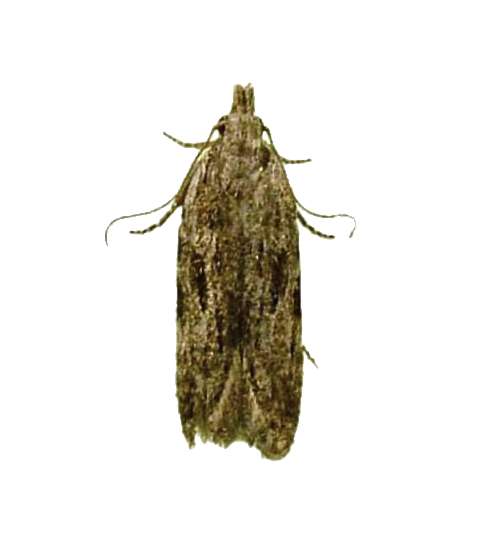


The main host crops are peach, apricot, nectarine, almond, plum and prune. Young larvae bore into buds and developing shoots causing them to wilt and die. When populations are high, spring larval feeding can cause substantial damage to trees. Larvae of the summer generations attack the fruit, usually making several entry holes near the stem end. Damaged fruit and twigs exude gum.
Adult moths are small 0.3-0.5 inches long, with light and dark grey mottled wings. There are scales on the front of the head giving it a pointed appearance. Each female can lay 80-90 eggs. Eggs are deposited singly on young and tender shoots, undersides of leaves and on developing fruits. Eggs are yellowish white to orange and oval shaped. Egg hatching occurs in 4-18 days depending on temperature. Young larvae are pale with light brown rings and a black head. Older larvae are chocolate brown with a dark brown head and prothorax. Mature larvae are roughly 0.5 inches long and pupate in 2-3 weeks. First and second instar larvae overwinter in silken cells called hibernacula. Pupae are brown in colour and smooth in appearance with no cocoon. The pupae from overwintering larvae can take up to 30 days to mature in cool spring temperatures. Pupation stage for summer generations is 7-11 days.
Peach twig borer, Anarsia lineatella larvae are firstly attracted to new shoot growth of the tree and secondly to maturing stone fruits. Larvae of early generations feed inside the terminal shoots, causing the leaves to wilt which leads to the death of the terminals. On young trees especially, repeated attack of the terminal branches can cause stunted tree growth. As the fruit pits harden and the fruit develops in colour the maturing fruits become more appealing to the larvae, which enter primarily through the stem and feed just underneath the skin or next to the pit. Older larval generations attack the fruit, usually making several entry holes near the stem end. Damaged fruit exude gum. Once the larvae have completed there development inside the fruit, small, sticky exit holes may be visible, which then attract other insects i.e. earwigs to enter the fruit through the tunnels that the peach twig borer created.
Russell IPM manufactures and supplies pheromone lure – the Qlure, traps and complete monitoring systems for Leek moth, Acrolepiopsis assectella, also known as onion moth. Pheromone trap data gives early warning of the infestation and will also alert the user to a low level of population before it becomes serious. The lure can be best applied with the Mothcatcher trap or Delta trap.